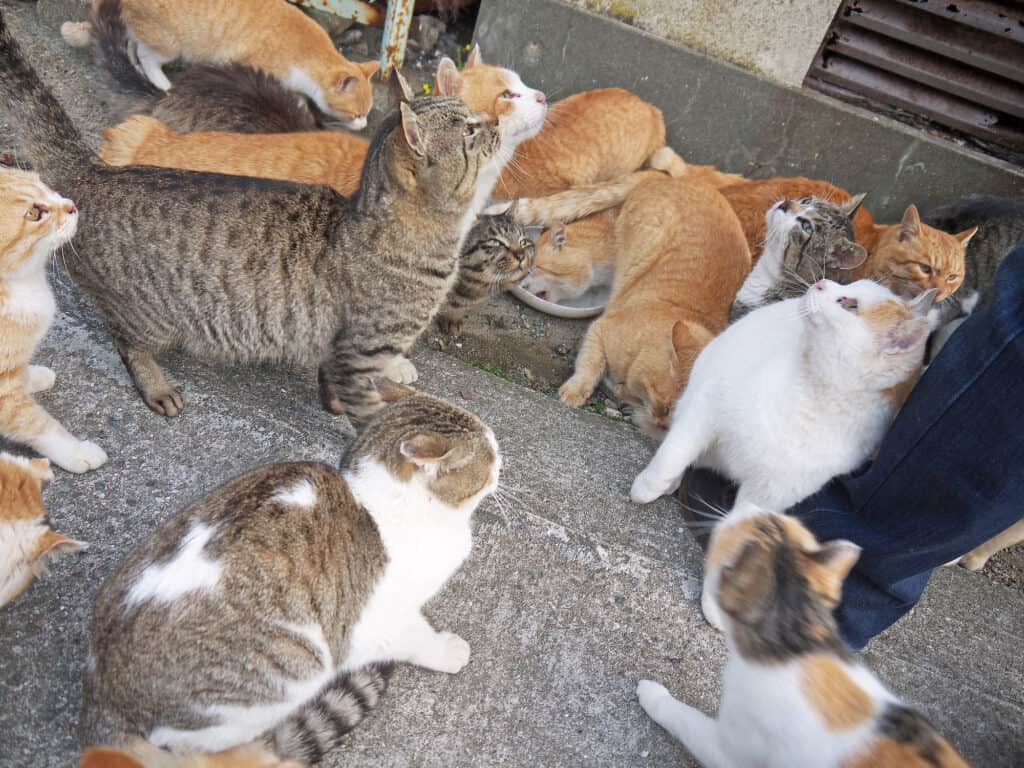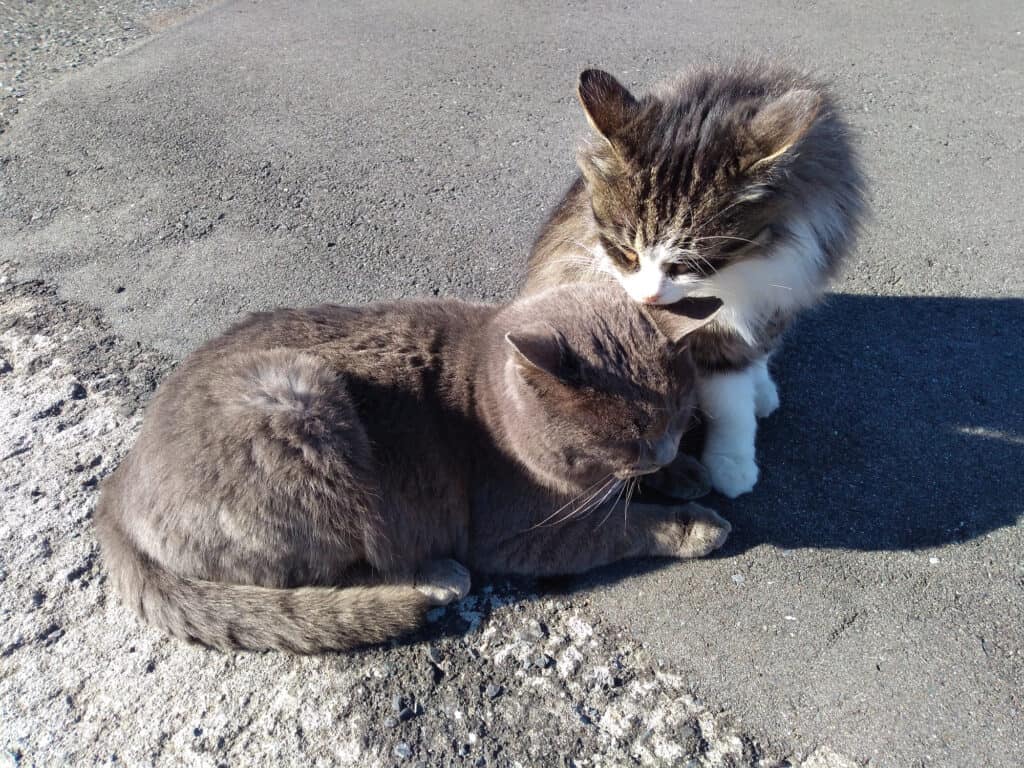If you’ve never heard of Japan’s “Cat Islands,” you are in ‘fur’ a wonderful treat. Also, you read that right.
Japan is host to 11 cat islands, or “neko shima”. These islands are relatively small, housing fewer than 500 humans in almost every case.
Still, each island has a cat population that dominates the human population, and this results in storms of cats and kittens pawing around, being cute, and living pretty harmonious lives.
It turns out that cats are just as playful and demure when they live in massive packs. They work together when they need to, lay in the shade when it works for them, and saunter up to the humans who visit these islands with treats.
But why in the world do these islands exist in the first place?
Why Are There So Many Cats on Some Japanese Islands?

Cats aren’t native to
Japan
, but they’ve been there for nearly 2,000 years.
©iStock.com/ES3N
Cats are native to Northern Africa, evolving from the African Wildcat, which still exists today. Humans started storing grains, and that attracted rodents. Rodents are exceptional carriers of disease, so their presence in our human food stores was not welcome.
Cats followed their rodent prey to our food stores and found themselves an unprecedented hub of rats, mice, and small critters to eat. Naturally, cats started hanging around our food stores for long periods of time hunting rodents.
This minimized the spread of disease from rats to humans, so the presence of cats was a great thing for us. Naturally, we domesticated them and brought them with us all around the globe.
The point is that cats aren’t native to Japan. Humans intentionally bred and freed an excessive amount of cats on these islands to diminish the mouse populations. The reason for eliminating mice might have been a little different on each island, however.
Some accounts say that fishermen brought cats to certain islands to cut down on the mice living in their boats. Other islands were used as nurseries for silkworms, which attracted mice and rats.
This is the reasoning that Japan’s travel website gives for the massive feline population on Tashirojima (the most famous of the islands). Cats ward off the rats, and fishermen and citizens offer up scraps and maybe even a warm place to sleep at night.
Tashirojima’s Past & Future

The history of cats on Tashirojima in Japan goes back to the 17th century.
©iStock.com/Nozomi Sato
The silkworm and fishing troubles on Japan’s islands were solved with cats beginning in the early 1600s. In fact, Japan’s government ordered all cats to be freed in 1602 in hopes of demolishing the rodent population. The idea was to let cats loose and strip down the spread of rodent-spread diseases. This was a smart move, too, considering the Black Plague was spread partially through rats and killed upwards of 25 million people.
Residents of Tashirojima at this time were raising silkworms and producing beautiful textiles. For that reason, there might have been a denser feline population because virtually everyone on the island had a strong interest in keeping rodents away. If rodents got into things, it would effectively squash the families’ livelihoods. So, everyone had kitties.
The dense population of cats released on a relatively small island was a hotbed for breeding and reproduction. With the seed planted, the cat population on the island has thrived ever since.
The island also has a strict ‘no dog’ policy, restricting cat predators from entering. House cats get a sort of haven of predator-free roaming rife with mice and treats from human visitors.
Natural Dangers on Tashirojima: The Tohuku Tsunami
Note that Tashirojima’s total area is 1.21 square miles located off the eastern coast of Japan. The island is a small freckle between Japan and the massive Pacific Ocean. This leaves it vulnerable to natural disasters and makes it dangerous for people to live there, especially if they’re living on the coast of the island. The island is so small, however, that most of the land therein is as exposed to natural disasters as the coasts are.
In 2011, a 9.1 magnitude earthquake took place less than 50 miles from the eastern coast of Japan. The fourth most powerful earthquake ever recorded in the world, it produced a tsunami with waves exceeding 130 feet high.
Inhabitants of the island and surrounding areas only received a few minutes of warning. Many of those who escaped found their homes and islands washed away upon their return. To make matters worse, freezing temperatures and excessive snowfall followed the tsunami making rescue efforts extremely difficult.
The aftermath would show nearly 20,000 deaths, more than 6,000 injuries, and over 2,500 people still reported missing in 2021.
The storm destroyed Tashirojima’s harbor. The harbor was a primary source of income and work for the fishermen who lived on the island. A significant number of families moved away from the island along with dozens of cats who fled the storm.
Cat Care for Tajiroshima’s Kitties
There are now more than 150 cats living on Tashirojima, while some accounts report that there are upwards of 800 cats living there.
The human population there is dwindling. The island’s school was moved to the mainland in the wake of the tsunami, and many of the fishermen moved as well. Still, the cats are looked after as well or better than any other feral cats in the world.
The cats attract a healthy amount of tourism and interest, drawing dozens of people per day to bring treats, offer up some scratches, and post adorable pictures and videos to keep more people coming.
Further, regular visitors who live in the area take it upon themselves to give the cats a little extra care. Reports of a vet visiting the island every couple of months show that people are looking after these animals to make sure they don’t fall prey to disease, illness, or malnutrition.
Cats in Japanese Culture

Cats are seen as symbols of protection and good fortune in Japan.
©iStock.com/Nozomi Sato
Cats are ubiquitous in Japanese culture. They’re seen as symbols of protection and good fortune and have been for hundreds of years.
There are literally cats all over Japanese pop culture from Maneki-Neko (knocking cat) to the deep-rooted good and evil cats peppered throughout Japanese folklore. They’ve been ingrained in Japanese culture for centuries so it’s hard to say that “cats mean this” or “cats mean that,” specifically.
So, when we say that cats are ‘symbols of good fortune,’ that’s just the boilerplate expression of what cats might mean to the culture at large. A deeper look at the history of cats in Japan shows a more complicated and sophisticated relationship.
That said, the proof is kind of in the pudding when it comes to Japan’s love of cats. To prove this, let’s do a little thought experiment.
Could This Happen in the United States?
Imagine an island off the coast of the United States. Now imagine that hundreds of years ago, hundreds of feral cats populated that island and lived there harmoniously with people. What are the odds that the island stays intact?
What are the chances that people and cats could live on that island for more than 600 years without being fundamentally disturbed? It happened on 11 islands in Japan, but do you think it would last in the context of American culture?
If you think the answer is ‘no,’ the reason might be that Japanese culture values cats more in general. Cat lovers across the United States might protest this, but the jury is still out. What do you think?
Can You Visit The Cat Islands?
Yes!
If you find yourself in Japan, you can certainly visit Tashirojima and give some quality pets to very cute kitties.
Another place to consider visiting is Aoshima Island. Aoshima is appropriately nicknamed “Cat Island.” Make sure to do some research before visiting other so-called “cat islands,” though, because some of them might not be as infested with cats as you’d like.
Many islands have large cat populations, but not all of them are so large that you’re certain to see a swarm of cats when you visit. Aoshima and Tashirojima give you a serious chance of seeing dozens of cats, many times in one spot, and ready to receive some pets and treats!
Up Next…
- Why Cats Like Boxes So Much (And What to Do About It)
- 7 Extinct Big Cats
- How Many Cats Are In The World?
- The 8 Best Books About Cats for Curious Owners – Available Today
The photo featured at the top of this post is © iStock.com/ES3N
Sources
- Smithsonian Magazine, Available here: https://www.smithsonianmag.com/arts-culture/japans-love-hate-relationship-with-cats-180975764/
- My Modern Met, Available here: https://mymodernmet.com/maneki-neko-japanese-lucky-cat/
- Pink Pangea, Available here: https://pinkpangea.com/2017/09/tajiroshima-japans-cat-island/
- Japan Travel, Available here: https://www.japan.travel/en/spot/1765/
- History, Available here: https://www.history.com/topics/middle-ages/black-death
FAQs (Frequently Asked Questions)
Why are there so many cats on islands in Japan?
The cat islands began when fishermen and silkworm producers needed a way to control the local mouse and rat populations. Over time, released cats bred and populated the islands where there were few predators and ample opportunities for food and support from humans.
Why are cats so popular in Japan?
Japan is home to many cat-themed products and media productions, along with the ever-popular ‘Maneki-Neko’ (also called the ‘beckoning cat) which commonly sits near doorways and symbolizes good luck and fortune.
This deep cultural interest and love for cats are likely rooted in the country’s folklore.
When did cats enter Japan?
Cats have been in Japan for nearly 2,000 years, although the exact date of entry isn’t known. Domesticated felines were likely first owned by nobility, and there’s even a theory that cats were first used to protect Buddhist texts from rats and mice in the country.
Thank you for reading! Have some feedback for us? Contact the AZ Animals editorial team.






